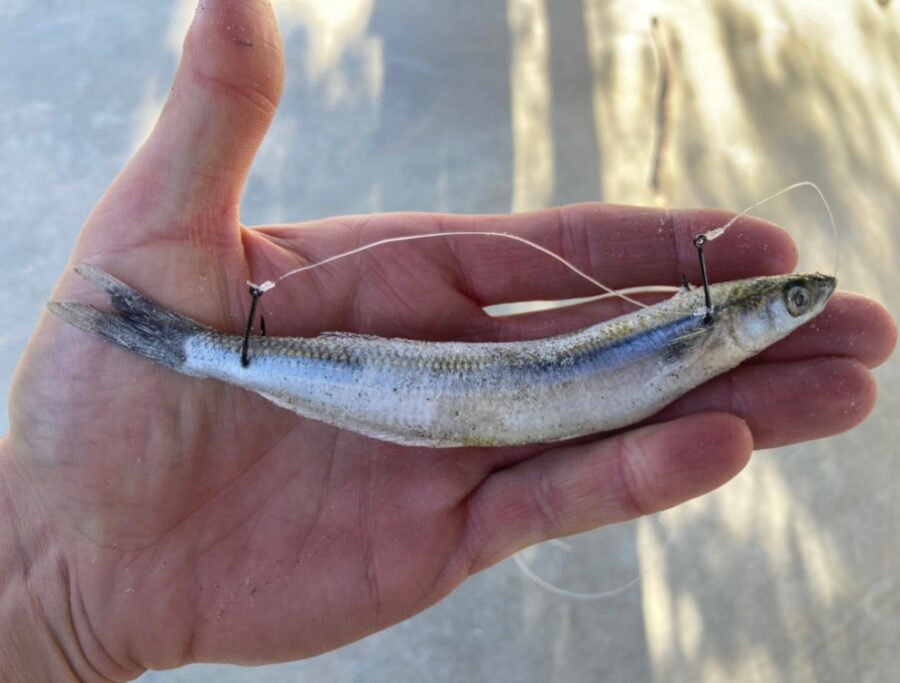Trailer Hook: What’s it For? And How to Tie One

Do you need to tie a trailer hook? After my last post, I received some questions on the concept of a stinger hook. This article is meant to provide some background. Trailer hooks (or stinger hooks) are commonly used with a number of fishing rigs to increase your chances of hooking up and catching your target fish.
When you only use one hook with longer baits, what happens if the fish bites the tail of your bait? It gets away free! That’s where the trailer hook comes in. You tie an additional hook below your original hook, allowing for a greater chance of hooking up when a fish bites that tail-end of your bait. Let’s cover the concept in a little more detail.
Common names: stinger hook, stinger rig, trailer hook, trailer rig
What is a Trailer Hook?
A Trailer hook, or a stinger hook, refers to a second hook that is added to your rig, below your main hook within a fishing rig. It is commonly used when your bait is relatively long. For example, if you use an anchovy or grunion as bait, the first hook will usually be placed near the head of your bait. The second hook will usually be placed closer to the tail.
By using that stinger rig style, if a fish bites that back half of your bait, you now have a hook in a good position. This method can be used with fresh bait, frozen bait and even artificial baits.
What Is a Trailer Hook Used For?
A trailer hook is used in a number of different scenarios. I usually use a stinger rig with some of the frozen baits I use while surf fishing. A few common baits that this method works well with are anchovies, grunion, sardines, and other “whole fish” baits. The same idea can be applied to lures.
Some people add trailer hooks to their spinner baits. I’ve even heard of anglers adding them to their swim baits. The bottom line is that anglers are always looking for ways to increase hook-up rates. If your bait is getting bit, but you aren’t hooking up, a common way to fix this is the addition of a stinger hook.
How To Tie a Trailer Hook
If you’re using frozen bait or sometimes even live bait, this method can be very effective. But, it can be intimidating trying to figure out how to tie a trailer rig. To ease the process, I’ve put together a video here on how to tie a stinger hook.
Some people like to use a treble hook for the second hook which can increase hook up rates as well. It isn’t always necessary though. I personally just use a standard inline hook. Below, you’ll find the gist of it along with a video-tutorial.
The concept:
- Tie your first hook as you normally would.
- Then, tie a 6-to-8-inch piece of line at the arch of your hook.
- Then, tie another hook to the end of that line.
I actually use this exact rig when targeting halibut in the surf. Here’s an example of using this rig and catching halibut with a stinger rig.
Subscribe Below
Subscribe to our newsletter!
We use something similar when trolling for salmon. A mooch rig. The front hook is sliding so you can adjust the length. We also take a whole anchovy and thread the line through then put on the trailer hook.
That’s a really interesting concept. I may have to try that. Thanks for the idea.
I’m using your method this weekend! Thanks for the info! In the past drifting in the bay I’ve used a treble stinger with some luck, but the treble is pointing to the head of the bait? (Live), notice your stinger’s point is upwards, does it make a difference? Also I nose pin the live bait, but your frozen is pinned at the gills?(cause it’s not swimming?) Going up north to fish new areas, Goleta and other areas north of Santa Barbara this weekend hope to get bigger peach! Thanks again!
yes the differences would be because the bait is dead and not swimming. Personally, the few times I’ve been able to use live bait, I just stick with the one hook through the nose because another hook usually kills it quick. The placement and angles of my hooks in this method are for a combo of ease and practicality in distance from one another. I don’t think it would matter much in terms of the angle the hook is facing given that the bait will likely be floating around in all sorts of directions.
Solid advice Nick, I’ve been using a trap hook for years on frozen bait.
You’ve been using it to target halibut or sharks?
Just critter fishing with my father on the pier. Don’t use a trap when fishing for the ‘toothy critters’
Outstanding rig for frozen or long live bait. You all should look up the knotless knot on YouTube. It is easy to tie, and really effective for utilizing flouro carbon line with the knotless knot. Enjoy, bros!